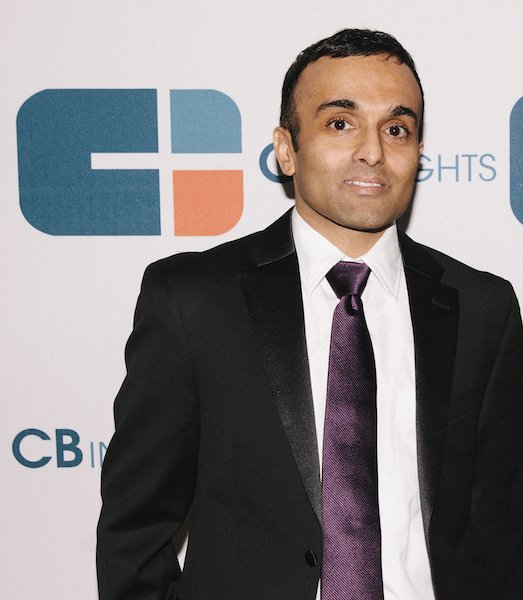It’s no secret that the insurance technology or “insuretech” sector has been booming in recent years, with big money being invested every day in high-tech startups looking to disrupt the insurance market.
Venture capitalists from New York to Silicon Valley and beyond have embraced the industry, seeing a major opportunity in a market ripe for disruption, and pouring staggering amounts in seed funding to fledgling companies like Oscar, Lemonade, Trov, Ladder, b.well, Slice, CoverHound, Denim, and countless others.
But how do these VC firms and incumbent carriers with VC arms (such as AXA Strategic Ventures and MassMutual Ventures) find these investment opportunities and figure out what makes them a good risk?
They turn to CB Insights.
The brainchild of co-founders Anand Sanwal, CEO, (pictured above) and Jonathan Sherry, the New York-based private market intelligence firm has its fingerprints all over the insuretech and fintech markets, and has quickly become the “go-to” source of information for not only the VC community but also for media covering the business. CB Insights has been cited hundreds of times by leading business media brands including The Wall Street Journal, Bloomberg, The New York Times, Fortune and CNBC.
But the paying customers – subscribers to CB Insights services beyond the free newsletters – are looking for answers to “massive strategic questions” that come from the aggregation and analysis of massive amounts of data along with machine learning, algorithms and data visualization. This helps corporations replace what CB Insights calls the “3 Gs” – Google searches, Gut instinct and Guys with MBAs.
“It’s time to move past the three Gs. Your biggest strategic decisions deserve better,” says the “About Us” section of the CB Insights website. “We mine terabytes of data and knowledge contained in patents, venture capital financings, M&A transactions, hiring, startup and investor websites, news sentiment, social media chatter, and more. Our software algorithmically analyzes this data to help our clients see where the world is going tomorrow, today.”
Think of it like the sabermetrics approach in Moneyball – but for corporations and VC firms (more on this analogy in the Q&A with Sanwal below).
Sanwal and Sherry both left lofty positions managing an innovation fund at American Express in 2008 to start what was originally called “Chubby Brain” Insights. While the turbulent economy of the time nearly nipped the fledgling venture in the bud, CB Insights made it through those rough early years. One big reason was a conscious decision to incorporate more personality into the newsletters with attention-grabbing subject lines and more opinionated content. Oh, and Sanwal famously closes each with “I love you.”
The tech industry definitely took notice, helping CB Insights to remarkable growth in the past few years. From a mere 1,400 subscribers at the end of 2010 to 51,000 in 2014, it has since exploded to 171,000 by mid 2016 and surpassed 232,000 as of Feb. 1.
And it doesn’t hurt that there’s no shortage of material to mine. Deal activity in the insurance tech space hit its highest annual total in 2016 (according to CB Insights data, naturally).
Total funding to insurance startups in 2016 hit $1.69 billion, the second consecutive year investment dollars to the space topped $1B. Why the boom?

“There’s a number of trends enabling startup formation in the insurance industry including massive new datasets and digital risks, unmet consumer expectations, and declining product relevance for the younger generation,” says CB Insights Senior Analyst Matthew Wong. “An overabundance of reinsurance capital as well as challenging market conditions for P/C insurers have also spurred incumbents to become more deeply interested and involved in participating in tech startup innovation.”
A large part of the early growth of insurance startup investment originated in healthcare as the passage of ACA spurred a number of new startups across consumer-focused brokerage models, employer brokerage models and even new carriers like Oscar Health Insurance, Wong says.
“Since then, we have seen insurance startup formation permeate more areas including in more complicated lines like life and small commercial,” Wong says. “Insurance tech startups today are spread across a number of different lines including renters, auto, pet and even title insurance. Less talked about is the number of entrepreneurs who have started up in insurance having previously founded or worked in other areas of fintech including lending, wealth management, and digital banking.”
Wong says he continues to see investor enthusiasm in insurance tech this year, but notes that two-thirds of all insurance tech investments in 2016 were at the seed-stage. “Venture capital is a natural selection process so as more startups go to market in 2017, how they are received in the market will have an effect on follow-on funding investment.”
Wong adds that while CB Insightsworks closely with a number of groups involved in innovation across the insurance industry, they also put out a weekly brief covering major themes, trends and investments in insurance tech that any insurance professional can subscribe to free here to keep up with the market.
While co-founder Jonathan Sherry spends the majority of his time 1) overseeing product and the team responsible for building it; 2) managing email marketing efforts; and 3) recruiting, Sanwal has become well known for the aforementioned personality he injects into daily newsletters. This serves a goal of being more conversational and approachable than typical dry and lifeless business technology and data communications.
Sanwal recently agreed to answer some questions from Insurance Forums about CB Insights and the unique niche it has managed to carve out that helps VC firms and legacy corporations identify and invest in fledgling startups setting out to disrupt an industry.

Insurance Forums Q&A with CB Insights Co-founder and CEO Anand Sanwal
Insurance Forums: How did CB Insights come to be – how did you spot the opportunity, and come up with a plan to address it that was different than anything else out there?
Anand Sanwal: Jonathan (Sherry), my co-founder, and I worked in venture, M&A and ran the $50M Chairman’s Innovation Fund at American Express before starting CB Insights. At the core, we saw technology impacting ‘old school’ industries at an alarming rate but the understanding by these incumbent players was poor to non-existent and relied on a mix of consultants, advisors and pundits who really didn’t know much. Our belief was that we could use probability to take on the pundit industrial complex and provide a superior level of insight into where technology is going using data and not decibels.
More detail:
Technology was impacting every industry and going well beyond ‘tech.’ From insurance to CPG to agriculture, technology was becoming fundamental to every industry.
Despite this, large incumbent companies had no way to understand these emerging business models, disruptive threats, competitor actions in any meaningful organized way. 52% of the S&P 500 has disappeared in the last 15 years and that pace of disruption was accelerating and yet most organizations were flying blind.
At the same time, there was increasingly massive amounts of data and technology available that would allow us to glean predictive insight from this data. So we began mining things like news media, VC financings, startup descriptions, patents, social media, web traffic stats to provide a probability-driven view of where tomorrow’s threats and opportunities lie.
Insurance Forums: What type of professionals make up your core audience – or in other words, who should be subscribing to CB Insights?
Sanwal: Our customers are large corporations (Global 5000) – folks like Microsoft, Castrol, Telefonica, GE and others. We work with many groups within corporations including:
• Corporate and business unit strategy
• Corporate innovation
• Competitive intelligence
• Market research/consumer insights
• Corporate M&A/corporate development
• Corporate venture
• CIO/CTO
• Product strategy
Insurance Forums: Seems like CB Insights has generated a ton of momentum in the past year, as evidenced by the huge spike in media mentions and a similar spike in subscribers. What has been the key to this growth, and how has this changed things for the operation?
Sanwal: We definitely hit our stride in the past year, and it was driven by two things:
First, corporations across industries have woken up to the idea that technology is going to either be a weapon they can wield to stay ahead and relevant or it will be a weapon used against them, and in this case, their fate is sealed. If you look at the $1B acquisitions of late, most were made by non-tech companies. So in some sense, the wind has been at our back as big cos try to maintain relevance and own the future.
Second, we have brought a unique perspective and voice to the market in that we are 100% data-driven and evidence-based. If you look at the history of tech trend discussion, the rigor and quality of work there has been abysmal. It has been pundits taking a single data point and drawing it into a trend (what we call anecdata). And what we are seeing is that smart executives gravitate toward our evidence-based approach because it’s built on facts, data science and machine learning and is as a result rigorous and right.

Q&A with Anand Sanwal (continued)
Insurance Forums: Tell us more about your “assault on the pundit industrial complex”
Sanwal: Corporations have traditionally made huge decisions on the basis of the ‘3 Gs:’
• Google searches
• Gut instinct
• Guys with MBAs
We are talking about decisions like ‘which industries to enter or which products to launch’ or ‘what is our competitor’s strategy and how should we react’ or ‘which new business models should we be exploring to stay competitive?’
These are ‘bet the farm’-type decisions. And shockingly, they were made with the 3 Gs. And the Guys with MBAs thing is really persistent and this is what we refer to as the ‘Pundit Industrial Complex.’ It’s that mix of consultants and advisors who candidly take one data point, put together a PowerPoint and a nice narrative and shill it to gullible buyers. If you’re an incumbent company, do you really want to figure out how to innovate from a consulting company that is using a business model which has not evolved in since 1926? It’s laughable.
You could throw an army of MBAs at our data and they wouldn’t do what we can do correctly because we’re solving problems that technology is perfectly suited for. It’s not dissimilar from what sabermetrics did in baseball (made famous by Moneyball) highlighting how data science can do better in player selection than scouts (baseball’s version of MBAs).
Couple of notes here:
Both Jon and I are ‘business guys’ in addition to being engineers. He attended Columbia’s MBA program and I attended Wharton.
We are not advocating for robo-corporate decisions but a balance between intuition and evidence-based decision making.
Insurance Forums: Tell us about the Future of Fintech conference – what type of professionals attend and what can they get out of it that they can’t find at other meetings? How will this year’s event change from the inaugural conference last year?
Sanwal: The Future of FinTech is an exclusive event. Because of the premium price point and the reputation our prior events have built, it attracts a very senior-level audience. And so folks really love that the heads of M&A, corporate CIOs, partners from VC firms, etc., are the types of folks who attend. In addition, the audience is also very global with our prior events drawing folks from Asia, Australia, the Middle East, Europe and of course North America.
Beyond the audience, what sets the event apart are a few things we focus on:
You will leave smarter – Our speaker lineup is always top notch with C-level execs from unicorns, public companies and the smartest investors out there. We couple this with our research team who incisively digs into all areas of fintech from insurance to payments to alternative data to blockchain and AI – and deconstructs each so you leave with new insights.
You will meet future collaborators – We spend a lot of time to ensure you meet the right folks. This is not just through accidental meetings at breaks, which happen, but by facilitated introductions and senior-level breakfasts, lunches and dinners we hold to ensure that you meet the right people. Our team is focused on ensuring you leave with 5-10 really valuable connections as we expect deals and business to get done as a result of the event.
You will have fun – We are irreverent in how we approach our content, we ask hard questions of speakers and we always have a few surprises as well.
The other big thing that many comment about is we don’t have sponsors at our event. There are no vendors speaking or you being pitched constantly. We’ve probably lost $1.5M in sponsorship fees due to our rules here but we think it’s important that the people, content and fun take focus.
This year’s event is bigger as we’re hosting it at the amazing Lincoln Center. We have two stages and the speaker lineup is shaping up to be even better than last year’s, which was already quite killer.
We will also be highlighting the FinTech 250 – the 250 most promising private fintech companies globally to give you sense into the coming wave of technological innovation.
Insurance Forums: What really catches your attention when it comes to generating new content? Or in other words, what about a startup or news about a deal makes you stand up and take notice?
Sanwal: We tend not to cover deals individually as there are lots of great folks who do that. We tend to look for signals across many deals. So when we see insurance companies filing patents related to autonomous vehicles, that is interesting. Or when we see non-tech companies investing in tech companies at a higher rate than tech companies, that catches our interest.
The other big thing for us is if we can tell that story in a visually interesting way as graphics and unique visualizations are very core to what we do.
Insurance Forums: Any hiccups or surprises you’ve had to deal with lately from a business perspective (the election, competition, market conditions, etc.)?
Sanwal: We tend not to worry about things we can’t control, i.e. election, competition, etc.
The company presents us with new challenges every year. When we were young, the focus was on making enough money to make payroll. Now, we don’t worry about that and the focus is on scaling and ensuring the culture we build is amazing. They are not major hiccups or surprises but things we see and have to get ahead of.
The recipe ultimately is pretty simple if you boil it down to its essentials. Build a great product, take care of customers, hire humble, smart and hungry people and ensure they’re learning, being challenged and around other smart folks.
Sign up for the free Insurance Tech Insights newsletter here
Thoughts or comments? Please share on this thread: ‘Moneyball’ for Insuretech
See also:












